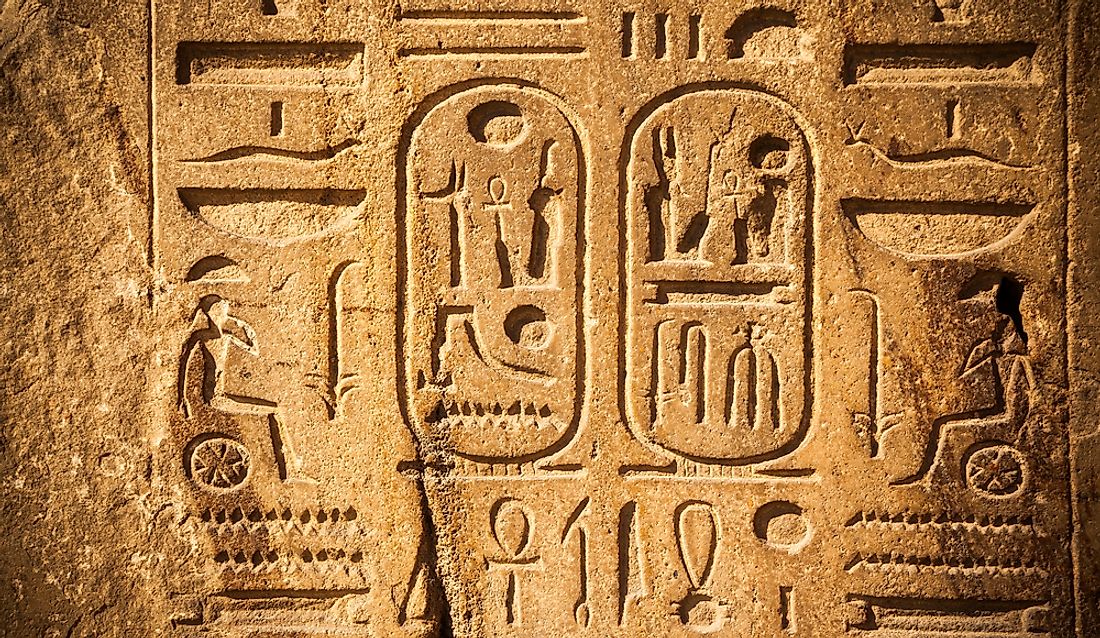What Languages Were Spoken in Ancient Egypt?

The study of Ancient Egypt and its contribution to modern civilization is majorly centered on the invention of independent writing systems that were developed in around 3400 BC in the form of hieroglyphs. The Ancient language is classified in the Afro-Asiatic phylum along with other language groups such as Omotic, Chadic, Cushitic, and Amazigh. The Ancient Egyptian language is also classified to a lesser extent in the Semito-Hamitic family of languages. Ancient Egyptian over the years evolved to different variations with records showing that the language was spoken even in the 17th century as the Coptic language. Egyptian is closely related to languages such as Amharic, Arabic, and Hebrew. The history of the language which has spurred four millennia is divided into six periods or phases as listed below.
Archaic Egyptian
The Archaic phase of the language consists of some of the earliest hieroglyphic writings such as those depicted on the Naqada II pottery. The phase is also made up of inscriptions from the Pre-dynastic period as well as those from the Early Dynastic period.
Old Egyptian
The phase lasted between 2600 BC and 2000 BC and is also known as the Old Kingdom language. The phase, which consists of the First intermediate period of the Kingdom, has its largest literature body written in the form of pyramid text. Tombs containing noble Egyptians from the time have autobiographical inscriptions on their walls in the alphabet and grammar of this phase as evidence. Some of the distinguishing aspects of this particular phase include the indication of plural through the tripling of determinatives and phonograms.
Middle Egyptian
The Middle Egyptian phase lasted between 2000 BC and 1300 BC and is commonly described as the Classical phase of the language. The phase represented the complete stage of Ancient Egyptian due to its linguistic eloquence and the development of some of the greatest literary works in Ancient Egypt. Evidence of the phase includes hieratic and hieroglyphic scripts such as the sarcophagi text. Some of the famous literary text from the phase includes the poetic text praising Pharaoh, the Wisdom text which instructed the ancient people on the way to lead life and text detailing adventures of individuals. Both written and spoken language in the phase lasted 500 years with the later period of the phase experiencing changes in vernacular Egyptian.
Late Egyptian
The late Egyptian phase lasted between 1300 BC and 700 BC. This phase began to appear in the previous period in around 1600 BC but did not fully develop up until 1300 BC. The phase coincided with the second phase of the new Kingdom which was also known as the Golden Age in the civilization of Ancient Egypt. The phase is evidenced by letters and documents from the Ramesside Administration period. The phase also contains secular and religious literature such as the “Instructions of Ani” and the “Story of Wenamun.”
Demotic Phase
The Demotic phase evolved from Late Egyptian and was used between the 7th century and the 5th century AD. The phase also consists of Egyptian script that had its roots in northern/Delta forms of hieratic. The Demotic script which is also known as the Enchorial Egyptian lasted over a millennium and was grouped into several developmental stages such as the Early Demotic, Middle/Ptolematic Demotic, and the Late Demotic. The Early Demotic originated in Lower Egypt and replaced Abnormal Hieratic following the reunification of Egypt under the rule of Psametik I. The Middle Demotic phase saw the rise of Demotic language to a high-status language before its decline due to Greek language influence. The Late Demotic saw the rapid decline in the literary use of the language due to Roman influence.
Coptic Phase
The Coptic phase is considered the last phase of the Ancient Egyptian language and lasted between the 4th and 14th centuries. Both the Greek and Demotic alphabet influenced the Coptic alphabet.
The Modern Use of Ancient Egyptian Languages
The use of Ancient Egyptian language still survives in the form of Coptic language which is used by the Coptic Church which has a handful of fluent speakers.











